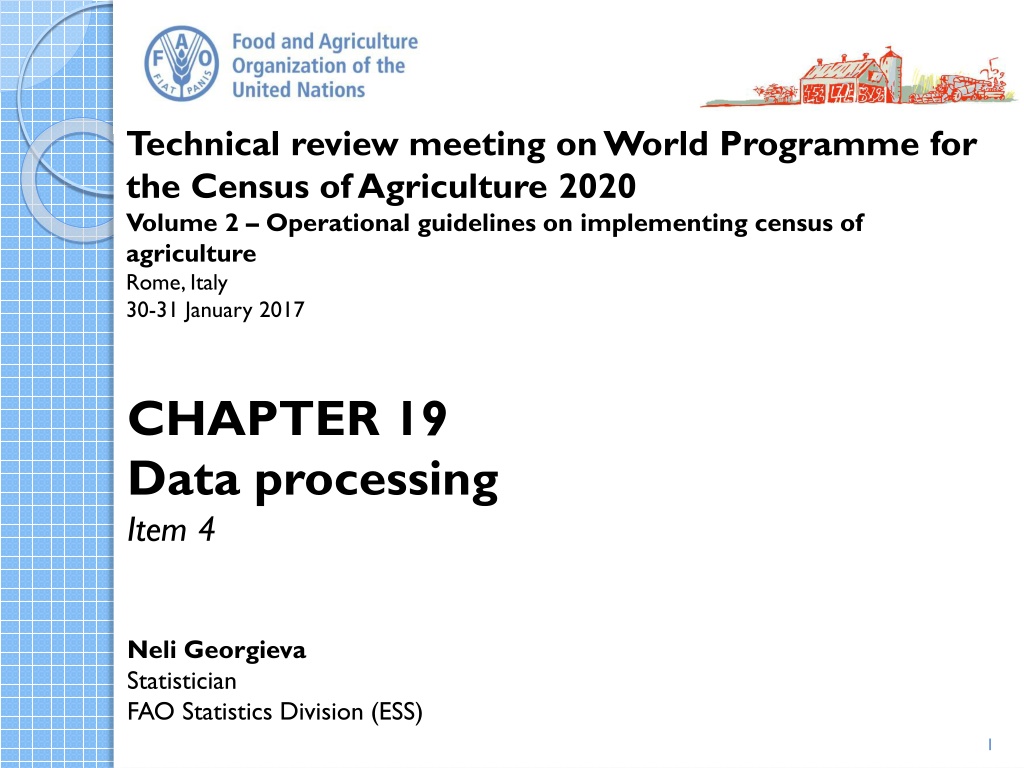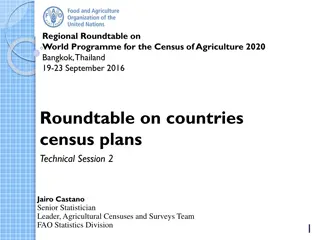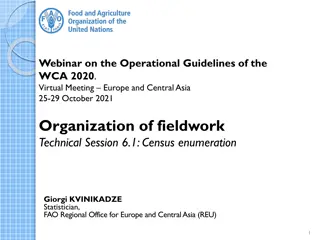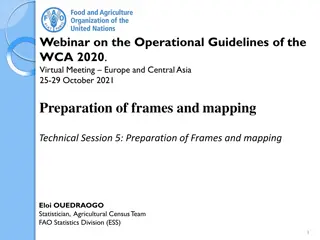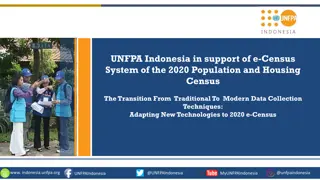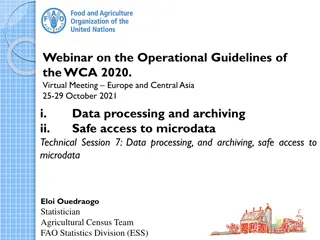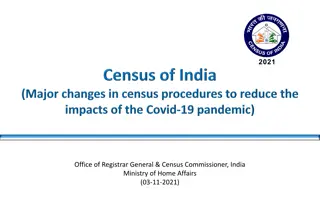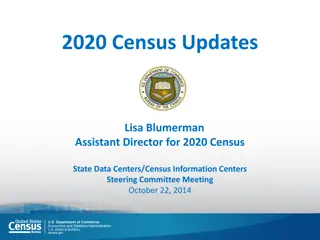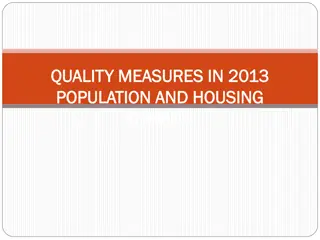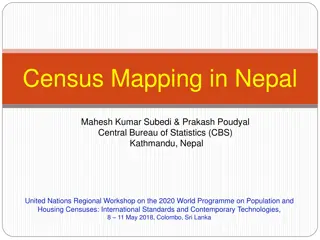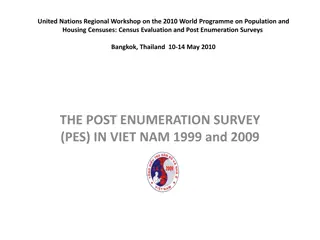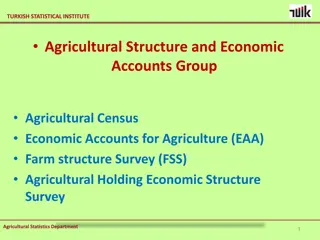Data Processing in Agricultural Census: Tools and Techniques
Hardware and software play a crucial role in the successful implementation of an agricultural census. The ICT strategy, hardware requirements, software selection, testing of computer programs, data processing activities like coding, editing, validation, and tabulation are all essential components discussed in this technical review meeting. Key points include strategic decision-making, technology infrastructure, staff capacity, data entry methods, and more.
Download Presentation

Please find below an Image/Link to download the presentation.
The content on the website is provided AS IS for your information and personal use only. It may not be sold, licensed, or shared on other websites without obtaining consent from the author. Download presentation by click this link. If you encounter any issues during the download, it is possible that the publisher has removed the file from their server.
E N D
Presentation Transcript
Technical review meeting on World Programme for the Census of Agriculture 2020 Volume 2 Operational guidelines on implementing census of agriculture Rome, Italy 30-31 January 2017 CHAPTER 19 Data processing Item 4 Neli Georgieva Statistician FAO Statistics Division (ESS) 1
CONTENT 1. Hardware and Software 2. Testing computer programmes 3. Data processing activities 4. Data coding and entry - Data entry methods 5. Data editing 6. Imputation 7. Data Validation and Tabulation 2
Hardware and Software The ICT strategy for the census should be part of the overall agricultural census strategy. It depends strongly on the data collection option and modality of census taking chosen. The decision needs to be taken at early stage to allow sufficient time for testing and implementing the data processing system. Key management issues need to be addressed: Strategic directions for the census program, often related to timeliness and cost; Existing technology infrastructure; Level of technical support available; Capacity of census agency staff; Technologies used in previous censuses; Establishing the viability of the technology; Cost-benefit; 3
Hardware and Software contd Hardware requirements Main characteristics of agricultural census data processing: large amounts of data to be entered in a short time with multi-users and parallel processing mode of servers; large amounts of data storage required; relatively simple transactions; relatively large numbers of tables to be prepared; extensive use of raw data files which need to be used simultaneously. method of data capture chosen by the census office Basic hardware equipment: Many data entry devices (PCs, hand-held devices, depending on data collection mode) Central processor/server and networks Fast, high-resolution graphics printers Number of PCs /handheld devices to be carefully considered Software Allows for a smooth data processing Preferable to use standard software maintained by the manufacturer with available documentation (to allow for data portability) 4
Testing computer programmes Considerable time is required to write computer programmes Computer programmes prepared should be tested with data from pretests and/or pilot census. Useful to enter erroneous data to test the full range of error detection Tabulation process to be simulated during the test Data transfer to be tested during the pilot census (for CAPI, CATI, CASI) 5
Data processing activities Data coding and entry Data Editing Validation and tabulation Calculation of sampling error and additional data analysis. Data coding and entry Data coding: operation where original information from the paper-based questionnaire, as recorded by enumerators, is replaced by a numerical code required for processing: Manual Computer Data entry methods: Manual; Optical scanning; Handheld device; Internet and computer-assisted telephone interviews (CASI and CATI). Manual data entry Time consuming Subject to human error More staff needed Rigorous verification procedure needed Simple software 6
Data processing activities contd Optical scanning O/ICR solution Advantages: Savings in salaries (responses can be automatically coded); Additional savings if using electronic images rather than physical forms; Automatic coding provides improvements in data quality, as consistent treatment of identical responses is guaranteed; Processing time can be reduced; Form design does not need to be as stringent as that required for optical mark recognition (OMR); Enables digital filing of forms resulting in efficiency of storage. Disadvantages: Higher costs of equipment (sophisticated hardware and software required); Character substitution, which affect data quality; Tuning of recognition engine and process to accurately recognize characters is critical with trade- offs between quality and cost. Handwritten responses must be written in a constrained response area. OMR solution Advantages: The capture of tick-box responses is much faster than manual entry; Equipment is reasonably inexpensive; It is relatively simple to install and run; It is a well-established technology that has been used for a number of years in many countries. Disadvantages: Can recognize marks made only by a special pencil on numbers or letters pre-printed on special questionnaires. Precision required in the printing process of questionnaires Restrictions on the type of paper/ink used; Precision required in cutting of sheets; Restrictions as to form design; 7
Data processing activities contd Handheld device Use of CAPI with electronic questionnaire, data entry completed directly by the enumerators Cost-effective Allows for automatic coding and editing Allows for skip patterns Thorough testing of the data-entry application required Functional testing Usability testing Data transfer testing CASI and CATI data entry Usually administered in conjunction with other methods Similar to handheld data collection - online form are used; an application guides the respondent through the questionnaire Testing the flow and skip patterns of the online form is essential 8
Examples of Data scanning and computer assisted systems use for 2010 round of agricultural censuses TECHNOLOGY COUNTRY Optical character recognition (OCR) Albania, Czech Republic, Greece, Ireland, Malawi, Norway, Philippines, Sweden Intelligent character recognition (ICR) Tanzania, Canada, Cook Island Argentina, Guyana, Iran, Jordan, Lithuania, Martinique, Mexico, Mozambique, Venezuela Brazil, Colombia, France, French CAPI/PDA Slovenia, Thailand, Estonia, Finland, Iceland, Italy, Latvia, Poland, Sweden, Spain CAWI, CATI, CAPI combined Source: FAO, Metadata reports; http://www.fao.org/economic/ess/ess-wca/en/ 9
Data editing Process involving the review and adjustment of collected census data. Purpose: to control the quality of the collected data The effect of editing questionnaires: to achieve consistency within the data and consistency within the tabulations (within and between tables) to detect and verify, correct or eliminate outliers Manual data editing (when using PAPI) Verify the completeness of the questionnaire minimize the non- response Should begin ASAP after the data collection and close to the source of data Very often errors are due to illegible handwriting Have some advantages: identify paper-based questionnaires to be returned for completion; helps to detect poor enumeration 10
Data editing contd Automated data editing Electronic correction of digital data Efficient editing approach for censuses, in terms of costs, required resources and processing time Checks the general credibility of the digital data with respect to missing data, range tests, and logical and/or numerical consistency Two ways: interactively at the data entry stage: immediately prompt error messages on the screen and/or may reject the data unless they are corrected; very useful for simple mistakes such as keying errors, but may greatly slow down the data entry process. aimed mainly at discovering errors made in data entry, while more difficult cases, such as non-response, are left for a separate automatic editing operation. Used with CAPI, CATI or CASI data collection methods using batch processing: after data entry; consists of a review of many questionnaires in one batch. The result is usually a file with error messages. All data collection modes. 11
Data editing contd Automated data editing cont d Two categories of errors: critical - needs to be corrected; could even block further processing or data capture non-critical - produce invalid or inconsistent results without interrupting the flow of subsequent processing phases; as many as possible to be corrected but avoiding over-editing Data editing (data detection) applied at several levels: At item level, which is usually called range checking ; At questionnaire level (checks are done across related items of the questionnaire); Hierarchical that involves checking items in related sub- questionnaires. 12
Imputation The process of addressing the missing, invalid or inconsistent responses identified during editing on the basis of knowledge available in the office When used, a flag should be set. Two imputation techniques commonly used: (a) cold-deck imputation (static look-up tables) (b) hot-deck imputation (dynamic look-up tables) Can be done manually or automatically by computer: Aspects to be considered for automatic editing and imputation: the immediate goal in an agricultural census is to collect data of good quality. If only a few errors are discovered, any method of correcting them may be considered satisfactory; it is important to keep a record of the number of errors discovered and the corrective action (by kind of correction); non-response can always be tabulated as such in a separate column. redundancy of information collected in the questionnaire can be useful to help detect error 13
Data validation and tabulation Validation Should run parallel to the other processes All data items should be checked for consistency and accuracy for all categories at different levels of geographic aggregation Macro-edit - the process of check at aggregated level. Focuses analysis on errors which have impact on published data. Validating the data before it leaves the processing centre ensures that errors that are significant and considered important can be corrected in the final file Final file - as the source database for the production of all dissemination products. Tabulation Very important part of the census; the most visible outcomes of the whole census operation and the most used output 14
FEEDBACK EXPECTED Relevance of this section on organisation of field work? Main elements missing? How can it be improved to be useful for census planners? 15
THANK YOU 16
